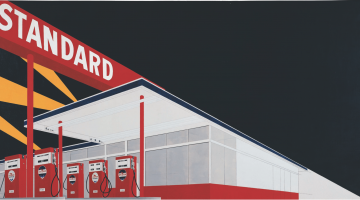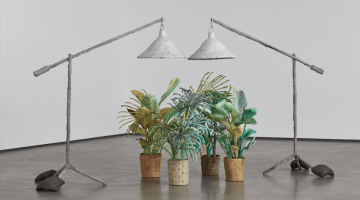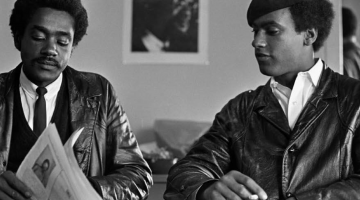The philosopher Hegel famously remarked that the owl of Minerva flies at dusk. Minerva is among other things the goddess of wisdom, and Hegel’s dictum asserts that knowledge, self-understanding, and wisdom are always retrospective, and that we can gain understanding of ourselves in a comprehensive and stable manner only with regard to our pasts and what we have already lived through. It is only when a period is drawing to a close that one might be in a position to grasp the shape of a period: What processes and forces shaped the period? Who were its decisive figures? What assumptions, beliefs, and worldviews did its bitterest adversaries share? Whose work will be seen as setting the terms for seriousness, and which seemingly central figures will vanish without a trace? But correlatively, on Hegel’s account, we are blocked from understanding ourselves in our contemporary environment. The problem then, as Kierkegaard remarked, is that we understand our lives backwards, but must live them forwards, without a secure and comprehensive understanding of the situations and problems out of concern for which we act.
In the mid-1980s, the leading intellectual question was the nature of the very period we were in. The easy questions were: Are we in a new artistic era? (Yes.) Is it rightly called “the postmodern”? (Yes, again.) Are there different kinds of postmodernisms . . . Are there different ways of self-clairvoyantly inhabiting this period, and are these ways of different value? (Yes.) et cetera. The problem arose in trying to characterize the different ways of being postmodern, and in offering reasons for preferring one way to another. Generally, the many and the wise considered the preferable kind of postmodernism to be “critical,” and the less preferable to be “conformist.” Jean-François Lyotard, Fredric Jameson, and other intellectuals offered different versions of this distinction. In the 1990s the questions concerning postmodernism faded without any consensus on their answers in place. The urgency of the questions had appeared to be a product of the Cold War. The need for a practical conception of non-conformist postmodernism had come to seem a recent version of a long-term ideological project: to provide some tangible evidence that the capitalist liberal democracies of the West fostered a kind of artistic freedom, and with it a broad menu of free lifestyles that were suppressed and unavailable in the communist, authoritarian East. So there had to be something artistically viable and vibrant and expressive of individual freedom after the end of modernism.
In our current century, the place of the question of postmodernism has been re-occupied by something now called “contemporary art.” Attempts to characterize the distinctive features of contemporary art are beset by the same questions, the same sort of alternative conceptions, and the same sense of interminable debates that beset the earlier attempts to characterize postmodernism. There’s no consensus on when contemporary art began, but we do imagine we know a thing or two about it. Like the ideological phantasm of postmodernism, it comes after modernism, but unlike modernism or postmodernism, it is “global.” That is, it’s a kind of art that no longer finds its home only in the major Euro-American or North Atlantic cities, but also in the smaller cities and towns of every continent. Contemporary art inherits the most securely established characteristics of postmodern art: its eclectic and hybrid quality, its easy acceptance of new technologies as artistic media, and indeed its refusal to exclude any perceptible material as a possible vehicle of art.
In previous issues of AQ I attempted an entrée into this new art through one narrow passage: the public speech and writing of its most visible representatives, that small number of curators who roam the earth deciding upon themes and choosing exemplary artists for the world’s biennials.1 Analyzing their opaque manner of speech and mountebank-like presentation, I argued that these characteristics were symptomatic of various cognitive blind spots and deficiencies. In the first column, I argued that this notorious opacity is an inheritance of a good deal of art world obscurantism in the twentieth century, and that the distinctive quality of the curators’ discourse was the result, in part, of two factors: first, the curator must meet many, not obviously reconcilable, demands from various constituencies, including museum professionals, critics, academic historians of recent art, local money-bags financing the shows, and of course the millions simply thirsting for the latest in the arts. The curator is like a member of the intelligentsia of the tourist industry, who has to wear the mask of P. T. Barnum pretending to be an intellectual. A second factor is negative: the curators’ discourse does not take place in the presence of the works themselves, and is not well placed to initiate a process of collective self-education and self-clarification about the works that are shown. In the second piece, I noted that the curators work with no articulate conception of artistic process, and seem to share unreflectively in the easy relativism of contemporary intellectual life, in particular in its manifestation in the art world as a practical conception of a work of art as whatever any individual artist declares to be such. With this conception, the questions of what makes someone an artist (is it more than declaring oneself one?), and more importantly, why anyone else should accept this stipulation of the honorific term “art” to anything whatsoever, never arise.2
There are signs that the owl of Minerva may be stirring with regard to the curator and these ideologies. Terry Smith, the art historian who has written most extensively in English, attempting overviews of recent art that highlight the role of the curator, has recently lamented that curators are no longer leading the way. In 2011, an ominously named organization called Independent Curators International hosted a conference in New York, with the equally ominous title “The Now Museum.” Leading curators and historians of contemporary art gathered for a discussion called “Contemporanizing History/Historicizing the Contemporary.” (Discerning readers will recognize that I am not making these titles up in a feeble attempt at mockery. Nor, alas, is it likely that they were produced by some academic-jargon-generating computer program.) The proceedings induced Smith to write a short book in 2012, titled Thinking Contemporary Curating.3 In it Smith claims that we have recently entered a new and unhealthy phase of contemporary art wherein “[c]urators are fading as agenda setters.”4 Smith attempts therein to answer the question “What is contemporary curatorial thought?”5 The italicization of the term “contemporary” is meant to prepare the reader for the claim that the distinctive feature of contemporary curatorial thought is that it addresses and orients itself to the exhibition of something called “contemporaneity.” The book purports to explicate this term, to distinguish the valuable kind of contemporaneity from its debased kinds, and to survey a range of exhibitions that successfully took up the challenge of exemplifying the valuable kind. This book has been followed recently by the publication of a volume of Smith’s interviews with 10 curators and thinkers, Talking Contemporary Curating, wherein a number of the interviewees address the question of contemporaneity.6 If the owl is roosting after a short flight, perhaps it is on these books. So, what is this contemporaneity that has allegedly shown itself to be the obscure target of a curatorial thought, and so accordingly a central concern of contemporary art?
Smith knows what contemporaneity is not: it is not rightly understood as a quality exhibited generally by contemporary art, particularly not a concern to be up to date. The concern to be of our moment is a concern for “the contemporary,” whose only virtue seems to be that it is easier to pronounce than contemporaneity. Smith does not so much reason about problems with the contemporary, but rather just seems to inhale and exhale a fashionable academic atmosphere. He writes that “to me, this phrase [the contemporary] conjures a (nervously) conformist—or, at best, a (coolly) complicit—contemporaneity, a mood familiar to the fashion industry . . . It is true that, at the margins, this is a mood scarcely distinguishable from genuinely contemporary différance, yet the difference increases as one slopes away from the other until it becomes huge, then total.”7 Presumably with the use of the italicized différance, Smith is invoking the once-fashionable thought of Jacques Derrida, wherein the term indicated a quasi-conceptual operation of “differing and deferring” that was allegedly at work within any process of signification, or indeed any ascription of identity to anything whatsoever. To me, however, noting this does not lessen, but rather intensifies the sense that I am reading gibberish. Smith nowhere offers any analysis of conformism or complicity, nor suggests any reason for thinking that they are in every case detrimental to the practice of the arts. At other points, Smith indicates that, in practice, a concern for the contemporary is a kind of classifying operation, again without arguing that this is necessarily problematic, instead of simply being an aspect of everyone’s muddling along in life. More pointedly, he suggests that in practice the contemporary is bound to a diffuse ideology of “presentism,” wherewith phenomena are presented in abstraction from their pasts, and with an impoverished sense of their possible futures. Finally, his use of the term the contemporary somehow secretes the sense that the abstracted phenomena presented under this term are definitive of what is and what might be.
The authentic sense of “contemporaneity” emerges by contrast with its debased sense in “the contemporary.” Rightly understood, contemporaneity involves the understanding and presentation of recent phenomena as saturated “with many different kinds of pasts, both as memories and expectations.”8 Smith repeats this characterization a few times, but offers nothing else by way of theoretical explication. A problem that immediately arises for this characterization of the concept of contemporaneity is that it makes no reference to anything contemporary. Smith seems to acknowledge this, but does not seem to view it as problematic, as he goes on to suggest that an exhibition of even the earliest works of art, such as the 80,000-year-old engraved pebble found in South Africa’s Blombos Cave could exhibit contemporaneity, if the pebble were exhibited in such a way as to induce a viewer’s awareness of its pasts and the choices made in its production. But then the sense of contemporaneity simply collapses into something like “artistic process.” If, in the end, all that Smith is claiming is that a good exhibition shows the process whereby the exhibited artifacts were created, then it’s hard to see what all, or indeed any, of the fuss is about. Smith leaves unaddressed the question of why such a concern is the distinctive task of contemporary curators.
The only other route that Smith suggests to determine the nature of contemporaneity is through the characterization of it as the object of curatorial thought. So what are the right sort of contemporary curators addressing? Smith writes that “curating is the exercise of curatorial thought within the practical exigencies of making an exhibition.”9 But since Smith characterizes curatorial thought as the exhibition of contemporaneity, his thought is moving in the smallest of circles: contemporaneity is the object of curatorial thought; the curators’ exhibitions display contemporaneity; if someone curates, she is guided by the concern to address contemporaneity. The owl of Minerva has not budged.
Should one look to the curators themselves then for some explication of what is meant by contemporaneity? Smith does claim that it can be exemplified in different ways, and explicitly cites three exemplary ways from exhibitions around the year 2000: Kirk Varnedoe’s attempts to link the present with the modernist past, Okwui Enwezor’s attempts to display the post-colonial condition, and Nicolas Bourriaud’s attempts to display the genre of contemporary art he influentially termed relational art. In the book of interviews, Smith repeatedly brings up the issue of how the particular curator’s work exhibits contemporaneity. In one response, Enwezor declares: “I’m saying that the post-colonial constellation may be understood as one layer of contemporaneity. I think it’s hard to define temporal or even spatial boundaries. I believe there is a close relationship between modernity, post-coloniality, and contemporaneity. And this alone can enable us to come to the point where we can have a radical sense of contemporaneity, of real being in the world.”10 Aside from the use of the word “this” in the last sentence, I cannot see any reason that these sentences are presented in this particular order: they convey as little or as much read in any sequence. Consider, then, the last sentence: a basic problem is the unclarity of the reference of the “this.” Most likely it is intended to refer to “a close relationship,” but although Enwezor has previously sketched some conception of modernity and post-coloniality, the meaning of contemporaneity is again left wholly unclarified, and so too its relationship to modernity and post-coloniality. The phrase “real being in the world” is used as an explicative apposition to “radical sense of contemporaneity,” but evidently this is an attempt to explain the obscure with the even more obscure.
Likewise, in another interview, the hyper-active Hans-Ulrich Obrist is asked: “is the connecting of culture the way you understand the idea of contemporaneity? If so, how do you actually curate contemporaneity—I mean you, personally?”11 Smith’s way of phrasing the question pretends that there is some shared understanding of contemporaneity, and allows Obrist to proceed by describing his legendarily frenzied pace of curating and interviewing artists, without addressing the theoretical point. In his curating, Obrist sees himself as simply taking up ideas suggested by artists—in particular their unrealized projects—and facilitating their completion and exhibition. The stylistic effect of this conception is that in Obrist’s speech and writing the distinction between thinking and name-dropping is abolished: “I grew up in the studio of artists [sic] Peter Fischli and David Weiss;”“Among them were the curators Marie-Claude Beaud and Jean de Loisy, who subsequently invited me . . .”; “In 2012, on a visit to LA, I had breakfast with the critic Kevin McGarry and the artist Ryan Trecartin . . .” et cetera.12 At the end of the interviews, Smith shares his own unrealized project of a creating a worldwide network that will include “a nomadic cohort of graduate students, young artists, curators, and activists” who will roam the earth “work[ing] on projects that explore connectivity, which I see as the biggest challenge to understanding our contemporaneity.”13 On the evidence of Smith’s writing there are a few other big challenges to understanding it.
Out of this brief consideration of these quite recent writings and interviews from the leading, internally prominent curators and the academics who are most intensively occupied with understanding their activities, one tentative conclusion suggests itself: the phantom term contemporaneity inherits the same charisma and persistent obscurity that the conceptual phantasm of a “critical postmodernism” had in the 1980s. Contemporaneity is a pseudo-concept generated by the cultural pressure upon curators, and members of the art world generally, to claim a specially privileged status by virtue to their intimate access to what’s happening right now, and the sense of what’s going to happen tomorrow emerging today. So another reason curators “talk like that” is their need to present themselves as the guardians of something that’s enormously valuable to experience, but which is too elusive for the public to access independently of the curators. Alas, not only is the owl of Minerva not flying but the talk of contemporaneity has not even awakened it.



